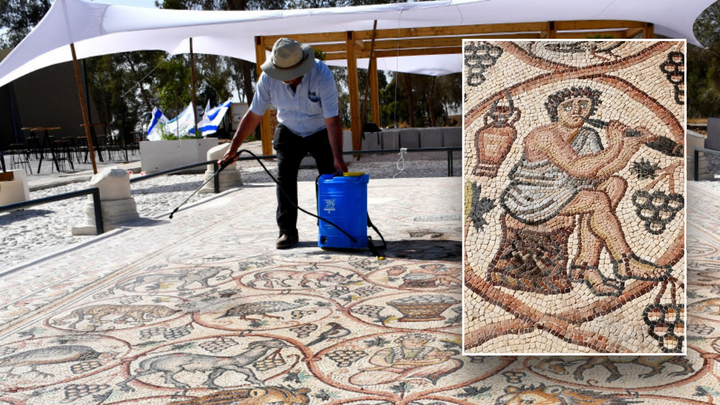A remarkable discovery has captivated historians, archaeologists, and religious scholars alike—a 1,600-year-old Christian mosaic has been unearthed from the ruins of an ancient monastery, offering a vivid glimpse into the early days of Christianity and its sacred art.
This intricately preserved mosaic, hidden beneath centuries of dust and debris, not only adds to our understanding of early Christian worship but also showcases the sophistication of religious art in the 4th and 5th centuries. Here’s everything we know so far about this extraordinary find.
Discovery of the 1,600-Year-Old Christian Mosaic
Where and When It Was Found
The Christian mosaic was uncovered during an excavation in a remote region of the Eastern Mediterranean—believed to be either southern Turkey, Jordan, or northern Israel, areas rich with early Christian heritage. A team of archaeologists from a joint international expedition discovered while surveying a neglected monastic site known from historical texts.
Initial excavation began in early 2025, and the mosaic was revealed only after several weeks of careful digging and preservation work.
The Condition and Preservation of the Mosaic
Remarkably, the mosaic was found in excellent condition. Despite being buried for over 16 centuries, its vivid colors, geometric patterns, and Christian symbols remain visible. Experts attribute its preservation to the dry climate and protective layer of collapsed stone above it, which shielded it from water damage and erosion.
Conservation teams are now working to stabilize and restore the mosaic for further study and potential public display.
Significance of the Mosaic in Christian History
Symbolism and Imagery in the Mosaic
The Christian mosaic is rich in symbolism. Common Christian icons such as fish (Ichthys), crosses, and grapevines appear alongside inscriptions in ancient Greek, suggesting their use as a sacred visual tool for monastic devotion. Some scholars believe the mosaic may depict scenes from the New Testament, including symbolic representations of the Last Supper or miracles performed by Jesus.
What It Tells Us About Early Christian Communities
This mosaic provides more than just artistic insight—it offers a cultural and spiritual snapshot of early Christian monastic life. It suggests that early monks placed a strong emphasis on visual storytelling and sacred symbolism, likely using the artwork as a focal point for reflection and teaching.
It also highlights the role of monasteries as centers of literacy, worship, and communal living during a time when Christianity was still solidifying its traditions.
Historical Context of the 4th–5th Century CE
The period when this Christian mosaic was created was pivotal in church history. Following Emperor Constantine’s Edict of Milan in 313 CE, Christianity transitioned from persecution to imperial endorsement. As the religion gained prominence, artistic expressions like mosaics became more common in churches and monasteries.
The Art and Craftsmanship of the Christian Mosaic
Materials and Techniques Used
The mosaic was composed of thousands of tiny tesserae—small pieces of colored stone, glass, and ceramic. Artisans carefully arranged these materials to form symmetrical designs, narrative panels, and theological symbolism.
Experts note the use of red and gold tones, which were associated with divinity and martyrdom in early Christian art.
Comparison with Other Christian Mosaics from the Era
This newly discovered Christian mosaic is being compared to those found in places like Ravenna (Italy) and Antioch (modern-day Turkey). While the designs vary regionally, they all share common Christian iconography, showing a network of artistic and theological exchange between early Christian communities across the Mediterranean.
The Monastery: A Window Into Early Christian Architecture
Architectural Layout and Function of the Site
The monastery where the mosaic was found likely consisted of a central chapel, monk cells, a communal dining hall, and possibly a library or scriptorium. The mosaic was located in what experts believe was a chapel or meditation room, where it would have played a central role in daily worship.
Other Artifacts and Findings on the Site
In addition to the Christian mosaic, archaeologists have discovered pottery fragments, oil lamps, religious inscriptions, and remnants of scrolls or codices—further confirming the site’s religious and educational significance.
Global Impact and Future Plans
How the Discovery Is Influencing Biblical Archaeology
The discovery is already reshaping academic conversations around early Christian art and liturgy. It reinforces the importance of monastic sites in the spread of Christianity and offers new perspectives on regional artistic influences during the late Roman period.
Scholars from around the world are collaborating to analyze the mosaic and its inscriptions to better understand their religious and historical meanings.
Plans for Exhibition and Public Access
Plans are underway to exhibit the Christian mosaic in a national museum once restoration is complete. In the meantime, digital 3D scans of the mosaic are being created for online viewing, allowing global audiences to explore the artwork up close.
Local officials are also considering the development of a heritage site around the monastery to promote archaeological tourism and preserve this sacred space for future generations.
Conclusion
The discovery of this 1,600-year-old Christian mosaic is more than an artistic marvel—it’s a spiritual and cultural bridge to early Christianity. Its detailed craftsmanship, religious symbolism, and historical context offer scholars and believers alike a powerful reminder of the depth and resilience of Christian tradition.
As research continues, the mosaic promises to unlock even more secrets from a pivotal era in religious history—making it one of the most exciting archaeological finds in recent memory.
Don’t Miss Out! Get the Latest News, Tips, and Updates from Us!
